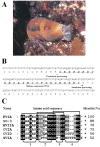Analgesic effect of highly reversible ω-conotoxin FVIA on N type Ca2+ channels
- PMID: 21172037
- PMCID: PMC3025903
- DOI: 10.1186/1744-8069-6-97
Analgesic effect of highly reversible ω-conotoxin FVIA on N type Ca2+ channels
Abstract
Background: N-type Ca2+ channels (Ca(v)2.2) play an important role in the transmission of pain signals to the central nervous system. ω-Conotoxin (CTx)-MVIIA, also called ziconotide (Prialt®), effectively alleviates pain, without causing addiction, by blocking the pores of these channels. Unfortunately, CTx-MVIIA has a narrow therapeutic window and produces serious side effects due to the poor reversibility of its binding to the channel. It would thus be desirable to identify new analgesic blockers with binding characteristics that lead to fewer adverse side effects.
Results: Here we identify a new CTx, FVIA, from the Korean Conus Fulmen and describe its effects on pain responses and blood pressure. The inhibitory effect of CTx-FVIA on N-type Ca2+ channel currents was dose-dependent and similar to that of CTx-MVIIA. However, the two conopeptides exhibited markedly different degrees of reversibility after block. CTx-FVIA effectively and dose-dependently reduced nociceptive behavior in the formalin test and in neuropathic pain models, and reduced mechanical and thermal allodynia in the tail nerve injury rat model. CTx-FVIA (10 ng) also showed significant analgesic effects on writhing in mouse neurotransmitter- and cytokine-induced pain models, though it had no effect on acute thermal pain and interferon-γ induced pain. Interestingly, although both CTx-FVIA and CTx-MVIIA depressed arterial blood pressure immediately after administration, pressure recovered faster and to a greater degree after CTx-FVIA administration.
Conclusions: The analgesic potency of CTx-FVIA and its greater reversibility could represent advantages over CTx-MVIIA for the treatment of refractory pain and contribute to the design of an analgesic with high potency and low side effects.
Figures






References
-
- Chaplan SR. Neuropathic pain: role of voltage-dependent calcium channels. Reg Anesth Pain Med. 2000;25:283–285. - PubMed
Publication types
MeSH terms
Substances
LinkOut - more resources
Full Text Sources
Other Literature Sources
Medical
Miscellaneous

